Recent Advances in the Preparation and Application of Bio-Based Polyurethanes
Abstract
:1. Introduction
2. Preparation of Bio-Based Polyurethane
2.1. Vegetable Oil-Based Polyurethane
2.1.1. Castor Oil
2.1.2. Soybean Oil
2.1.3. Tung Oil
2.2. Polysaccharide-Based Polyurethane
2.2.1. Starch
2.2.2. Cellulose
2.2.3. Chitosan
2.3. Lignin-Based Polyurethane
3. Application of Bio-Based Polyurethanes
3.1. Flame-Retardant Materials
3.2. Food Packaging
3.3. Self-Healing Materials
3.4. Sensing Materials
3.5. Other Applications
4. Conclusions and Outlook
Author Contributions
Funding
Conflicts of Interest
References
- Yang, Y.; Haurie, L.; Wang, D.-Y. Bio-based materials for fire-retardant application in construction products: A review. J. Therm. Anal. Calorim. 2022, 147, 6563–6582. [Google Scholar] [CrossRef]
- Heinrich, L.A. Future opportunities for bio-based adhesives–advantages beyond renewability. Green Chem. 2019, 21, 1866–1888. [Google Scholar] [CrossRef]
- Yin, L.; Zhang, B.; Tian, M.; Ning, N.; Wang, W. Synthesis and applications of bio-based waterborne polyurethane, a review. Prog. Org. Coat. 2024, 186, 108095. [Google Scholar] [CrossRef]
- Shen, Z.; Zheng, L.; Li, C.; Liu, G.; Xiao, Y.; Wu, S.; Liu, J.; Zhang, B. A comparison of non-isocyanate and HDI-based poly (ether urethane): Structure and properties. Polymer 2019, 175, 186–194. [Google Scholar] [CrossRef]
- Verdolotti, L.; Oliviero, M.; Lavorgna, M.; Santillo, C.; Tallia, F.; Iannace, S.; Chen, S.; Jones, J.R. “Aerogel-like” polysiloxane-polyurethane hybrid foams with enhanced mechanical and thermal-insulating properties. Compos. Sci. Technol. 2021, 213, 108917. [Google Scholar] [CrossRef]
- Liu, B.; Liu, Z.; Wei, H.; Meng, Y.; Hou, Q.; Wang, A.; Zhang, Y.; Han, E.; Hu, S.; Zhou, J. Performance characterization and biocompatibility assessment of silicone polyurethanes for polymer heart valve applications. RSC Adv. 2024, 14, 10858–10873. [Google Scholar] [CrossRef] [PubMed]
- Zeng, Y.; Li, H.; Li, J.; Yang, J.; Chen, Z. Preparation and characterization of solvent-free anti-corrosion polyurethane-urea coatings. Surf. Interfaces 2023, 36, 102504. [Google Scholar] [CrossRef]
- Carbonell-Blasco, M.P.; Moyano, M.A.; Hernández-Fernández, C.; Sierra-Molero, F.J.; Pastor, I.M.; Alonso, D.A.; Arán-Aís, F.; Orgilés-Calpena, E. Polyurethane Adhesives with Chemically Debondable Properties via Diels–Alder Bonds. Polymers 2023, 16, 21. [Google Scholar] [CrossRef] [PubMed]
- Liu, K.; Wang, M.; Huang, C.; Yuan, Y.; Ning, Y.; Zhang, L.; Wan, P. Flexible Bioinspired Healable Antibacterial Electronics for Intelligent Human-Machine Interaction Sensing. Adv. Sci. 2024, 11, 2305672. [Google Scholar] [CrossRef] [PubMed]
- Xiong, W.; Chen, B.; Peng, J.; Luo, X.; Pan, X.; Xiao, Z.; Gong, W.; Huang, Z.; Chu, Z.; Zhang, X. A dual-crosslinking strategy for waterborne polyurethane coatings to achieve outstanding anti-smudge and anti-corrosion properties. Chem. Eng. J. 2024, 490, 151509. [Google Scholar] [CrossRef]
- Paraskar, P.M.; Prabhudesai, M.S.; Hatkar, V.M.; Kulkarni, R.D. Vegetable oil based polyurethane coatings–A sustainable approach: A review. Prog. Org. Coat. 2021, 156, 106267. [Google Scholar] [CrossRef]
- Malewska, E.; Kurańska, M.; Tenczyńska, M.; Prociak, A. Application of Modified Seed Oils of Selected Fruits in the Synthesis of Polyurethane Thermal Insulating Materials. Materials 2023, 17, 158. [Google Scholar] [CrossRef] [PubMed]
- Gómez-Jiménez-Aberasturi, O.; Ochoa-Gómez, J.R. New approaches to producing polyols from biomass. J. Chem. Technol. Biotechnol. 2017, 92, 705–711. [Google Scholar] [CrossRef]
- Badakhshanian, E.; Ghaemy, M. Synthesis, characterization, and properties of a new polyurethane elastomer based on tragacanth gum polysaccharide. J. Elastomers Plast. 2022, 54, 1025–1039. [Google Scholar] [CrossRef]
- Cavalaglio, G.; Mecca, I.; Iodice, P.; Giannoni, T.; Gelosia, M.; Nicolini, A.; Barros Lovate Temporim, R. Life Cycle Assessment of Polyol Production from Lignin via Organosolv and Liquefaction Treatments. Sustainability 2023, 15, 15905. [Google Scholar] [CrossRef]
- Gnanasekar, P.; Chen, H.; Luo, Q.; Tanguy, N.; Li, L.-C.; Chen, J.; Yan, N. Mechanically Robust, Degradable, Catalyst-Free Fully Bio-Based Shape Memory Polyurethane: Influence of a Novel Vanillin–Alaninol Chain Extender. ACS Sustain. Chem. Eng. 2022, 10, 5203–5211. [Google Scholar] [CrossRef]
- Tran, H.T.; Deshan, A.D.K.; Doherty, W.; Rackemann, D.; Moghaddam, L. Production of rigid bio-based polyurethane foams from sugarcane bagasse. Ind. Crops Prod. 2022, 188, 115578. [Google Scholar] [CrossRef]
- Das, S.; Pandey, P.; Mohanty, S.; Nayak, S.K. Study of UV aging on the performance characteristics of vegetable oil and palm oil derived isocyanate based polyurethane. Korean J. Chem. Eng. 2017, 34, 523–538. [Google Scholar] [CrossRef]
- Ionescu, M.; Radojčić, D.; Wan, X.; Petrović, Z.S.; Upshaw, T.A. Functionalized vegetable oils as precursors for polymers by thiol-ene reaction. Eur. Polym. J. 2015, 67, 439–448. [Google Scholar] [CrossRef]
- Stradolini, P.; Gryczak, M.; Petzhold, C.L. Polyols from castor oil (Ricinus communis) and epoxidized soybean oil (Glycine max) for application as a lubricant base. J. Am. Oil Chem. Soc. 2024, 101, 321–334. [Google Scholar] [CrossRef]
- Xu, Q.; Lin, J.; Jiang, G. Synthesis, characterization and properties of soybean oil-based polyurethane. Polymers 2022, 14, 2201. [Google Scholar] [CrossRef] [PubMed]
- Feng, Y.; Man, L.; Hu, Y.; Chen, L.; Xie, B.; Zhang, C.; Yuan, T.; Yang, Z. One-pot synthesis of polyurethane-imides with tailored performance from castor and tung oil. Prog. Org. Coat. 2019, 132, 62–69. [Google Scholar] [CrossRef]
- Pang, M.; Dong, S.; Zou, G.; Zhao, J.; Li, H.; Li, L. Study on reduction potential of curing agent in sustainable bio-based controlled release coatings. Polym. Test. 2023, 127, 108193. [Google Scholar] [CrossRef]
- Polaczek, K.; Kurańska, M.; Auguścik-Królikowska, M.; Prociak, A.; Ryszkowska, J. Open-cell polyurethane foams of very low density modified with various palm oil-based bio-polyols in accordance with cleaner production. J. Clean. Prod. 2021, 290, 125875. [Google Scholar] [CrossRef]
- Bohórquez, W.F.; Orjuela, A.; Solarte, S.A.; García-Nunez, J.S.A. Natural Oil Polyol from High-Oleic Palm Oil─ Reaction Kinetics and Monitoring Using Near-Infrared Spectroscopy. Ind. Eng. Chem. Res. 2023, 62, 10024–10039. [Google Scholar] [CrossRef]
- Zuliani, A.; Rapisarda, M.; Chelazzi, D.; Baglioni, P.; Rizzarelli, P. Synthesis, characterization, and soil burial degradation of biobased polyurethanes. Polymers 2022, 14, 4948. [Google Scholar] [CrossRef] [PubMed]
- Lee, J.H.; Kim, S.H.; Oh, K.W. Bio-based polyurethane foams with castor oil based multifunctional polyols for improved compressive properties. Polymers 2021, 13, 576. [Google Scholar] [CrossRef]
- Su, Y.; Ma, S.; Wang, B.; Xu, X.; Feng, H.; Hu, K.; Zhang, W.; Zhou, S.; Weng, G.; Zhu, J. High-performance castor oil-based polyurethane thermosets: Facile synthesis and properties. React. Funct. Polym. 2023, 183, 105496. [Google Scholar] [CrossRef]
- Tuo, Y.; Luo, X.; Xiong, Y.; Xu, C.-A.; Yuan, T. A Novel Polyfunctional Polyurethane Acrylate Derived from Castor Oil-Based Polyols for Waterborne UV-Curable Coating Application. Polymers 2024, 16, 949. [Google Scholar] [CrossRef] [PubMed]
- Lou, W.; Dai, Z.; Jiang, P.; Zhang, P.; Bao, Y.; Gao, X.; Xia, J.; Haryono, A. Development of soybean oil-based aqueous polyurethanes and the effect of hydroxyl value on its properties. Polym. Adv. Technol. 2022, 33, 2393–2403. [Google Scholar] [CrossRef]
- Li, X.; Zhao, T.; Wang, H.; Chu, X.; Xing, X.; Liu, S.; Tang, E.; Xu, X. External surfactant-free waterborne polyurethane grafted fluorine-containing acrylic copolymer with high hardness and low water absorption using chlorinated soybean oil-based urethane acrylate as polyol. J. Adhes. Sci. Technol. 2021, 35, 1909–1923. [Google Scholar] [CrossRef]
- Dai, Z.; Jiang, P.; Lou, W.; Zhang, P.; Bao, Y.; Gao, X.; Xia, J.; Haryono, A. Preparation of degradable vegetable oil-based waterborne polyurethane with tunable mechanical and thermal properties. Eur. Polym. J. 2020, 139, 109994. [Google Scholar] [CrossRef]
- Li, M.; Ding, H.; Yang, X.; Xu, L.; Xia, J.; Li, S. Preparation and properties of self-healing polyurethane elastomer derived from tung-oil-based polyphenol. ACS Omega 2019, 5, 529–536. [Google Scholar] [CrossRef] [PubMed]
- Zhao, B.; Song, F.; Zhao, Q.; Pan, Z.; Xue, Y.; Feng, G.; Zhang, M.; Zhou, Y. Synthesis of tung oil-based polyphenols via phosphotungstic acid loaded tung meal-based carbon-catalyzed Friedel-Crafts alkylation: A smart way to access renewable bio-based polyurethanes. Chem. Eng. J. 2023, 473, 145477. [Google Scholar] [CrossRef]
- Zhou, W.; Bo, C.; Jia, P.; Zhou, Y.; Zhang, M. Effects of tung oil-based polyols on the thermal stability, flame retardancy, and mechanical properties of rigid polyurethane foam. Polymers 2018, 11, 45. [Google Scholar] [CrossRef] [PubMed]
- He, Y.; Zhu, Y.; Xue, X.; Song, Y.; Hu, G.; Wang, Q.; Jia, R.; Xu, X.; Shi, J. Bio-based waterborne polyurethane structural color films with high stability. J. Appl. Polym. Sci. 2024, 141, e55119. [Google Scholar] [CrossRef]
- Li, Z.; Qiu, D.; Wang, Y.; Zhang, Y.; Mo, Y.; Zuo, R. Preparation and Characterization of Porous High-Amylose Corn Starch. Starch-Starke 2024, 76, 2300091. [Google Scholar] [CrossRef]
- Chi, C.; Guo, X.; Zhou, Y.; Chen, B.; He, Y. A facile method for isolating long branch-chains of amylopectin from starch by preheating and pullulanase treatment. Ind. Crops Prod. 2023, 191, 115987. [Google Scholar] [CrossRef]
- Zhou, Y.; Tian, H.; Mei, Z.; Liao, Y.; Wang, M. Catalytic liquefaction of starch by sulfamic acid and its curing kinetics for preparing polyurethane. J. Therm. Anal. Calorim. 2023, 148, 13851–13858. [Google Scholar] [CrossRef]
- Liang, Y.; Zhang, D.; Zhou, M.; Xia, Y.; Chen, X.; Oliver, S.; Shi, S.; Lei, L. Bio-based omniphobic polyurethane coating providing anti-smudge and anti-corrosion protection. Prog. Org. Coat. 2020, 148, 105844. [Google Scholar] [CrossRef]
- Lubczak, R.; Szczęch, D.; Broda, D.; Wojnarowska-Nowak, R.; Kus-Liśkiewicz, M.; Dębska, B.; Lubczak, J. Polyetherols and polyurethane foams from starch. Polym. Test. 2021, 93, 106884. [Google Scholar] [CrossRef]
- Lubczak, R.; Szczęch, D. Polyurethane foams with starch. J. Chem. Technol. Biotechnol. 2019, 94, 109–119. [Google Scholar] [CrossRef]
- Mo, Y.; Huang, X.; Yue, M.; Hu, L.; Hu, C. Preparation of nanocellulose and application of nanocellulose polyurethane composites. RSC Adv. 2024, 14, 18247–18257. [Google Scholar] [CrossRef] [PubMed]
- Maiuolo, L.; Olivito, F.; Algieri, V.; Costanzo, P.; Jiritano, A.; Tallarida, M.A.; Tursi, A.; Sposato, C.; Feo, A.; De Nino, A. Synthesis, characterization and mechanical properties of novel bio-based polyurethane foams using cellulose-derived polyol for chain extension and cellulose citrate as a thickener additive. Polymers 2021, 13, 2802. [Google Scholar] [CrossRef] [PubMed]
- Szpiłyk, M.; Lubczak, R.; Lubczak, J. The biodegradable cellulose-derived polyol and polyurethane foam. Polym. Test. 2021, 100, 107250. [Google Scholar] [CrossRef]
- Szpiłyk, M.; Lubczak, R.; Walczak, M.; Lubczak, J. Polyol and polyurethane foam from cellulose hydrolysate. J. Chem. Technol. Biotechnol. 2021, 96, 881–889. [Google Scholar] [CrossRef]
- Hou, D.-F.; Liu, Z.-Y.; Zhou, L.; Tan, H.; Yang, W.; Yang, M.-B. A facile strategy towards heterogeneous preparation of thermoplastic cellulose grafted polyurethane from amorphous regenerated cellulose paste. Int. J. Biol. Macromol. 2020, 161, 177–186. [Google Scholar] [CrossRef] [PubMed]
- Asrahwi, M.A.; Rosman, N.A.; Shahri, N.N.M.; Santos, J.H.; Kusrini, E.; Thongratkaew, S.; Faungnawakij, K.; Hassan, S.; Mahadi, A.H.; Usman, A. Solid-state mechanochemical synthesis of chitosan from mud crab (Scylla serrata) chitin. Carbohydr. Res. 2023, 534, 108971. [Google Scholar] [CrossRef] [PubMed]
- Di Nardo, T.; Hadad, C.; Van Nhien, A.N.; Moores, A. Synthesis of high molecular weight chitosan from chitin by mechanochemistry and aging. Green Chem. 2019, 21, 3276–3285. [Google Scholar] [CrossRef]
- Gao, Y.; Geng, X.; Wang, X.; Han, N.; Zhang, X.; Li, W. Synthesis and characterization of microencapsulated phase change materials with chitosan-based polyurethane shell. Carbohydr. Polym. 2021, 273, 118629. [Google Scholar] [CrossRef] [PubMed]
- Strzałka, A.M.; Lubczak, J. Polyols and Polyurethane Foams Based on Water-Soluble Chitosan. Polymers 2023, 15, 1488. [Google Scholar] [CrossRef] [PubMed]
- Javaid, M.A.; Zia, K.M.; Zafar, K.; Khosa, M.K.; Akram, N.; Ajmal, M.; Imran, M.; Iqbal, M.N. Synthesis and molecular characterization of chitosan/starch blends based polyurethanes. Int. J. Biol. Macromol. 2020, 146, 243–252. [Google Scholar] [CrossRef] [PubMed]
- Jia, G.; Innocent, M.T.; Yu, Y.; Hu, Z.; Wang, X.; Xiang, H.; Zhu, M. Lignin-based carbon fibers: Insight into structural evolution from lignin pretreatment, fiber forming, to pre-oxidation and carbonization. Int. J. Biol. Macromol. 2023, 226, 646–659. [Google Scholar] [CrossRef] [PubMed]
- Guofu, Q.; Yihuan, L.; Fan, Y.; Xin, H.; Ning, Z.; Kai, G. Grafting modification of lignin via ring-opening polymerization. Prog. Chem. 2020, 32, 1547. [Google Scholar]
- Dutta, K.; Saikia, A.; Singh, A. Epoxidation and grafting route to prepare thin and flexible polymer film with high lignin content. React. Funct. Polym. 2023, 192, 105720. [Google Scholar] [CrossRef]
- Wang, X.; Leng, W.; Nayanathara, R.O.; Caldona, E.B.; Liu, L.; Chen, L.; Advincula, R.C.; Zhang, Z.; Zhang, X. Anticorrosive epoxy coatings from direct epoxidation of bioethanol fractionated lignin. Int. J. Biol. Macromol. 2022, 221, 268–277. [Google Scholar] [CrossRef] [PubMed]
- Gouveia, J.R.; Garcia, G.E.; Antonino, L.D.; Tavares, L.B.; Dos Santos, D.J. Epoxidation of kraft lignin as a tool for improving the mechanical properties of epoxy adhesive. Molecules 2020, 25, 2513. [Google Scholar] [CrossRef] [PubMed]
- Li, X.; Chen, X.; Zhang, S.; Yin, Y.; Wang, C. UV-resistant transparent lignin-based polyurethane elastomer with repeatable processing performance. Eur. Polym. J. 2021, 159, 110763. [Google Scholar] [CrossRef]
- Zhang, Y.; Yan, R.; Ngo, T.-d.; Zhao, Q.; Duan, J.; Du, X.; Wang, Y.; Liu, B.; Sun, Z.; Hu, W. Ozone oxidized lignin-based polyurethane with improved properties. Eur. Polym. J. 2019, 117, 114–122. [Google Scholar] [CrossRef]
- Wang, D.; Shan, Y.; Liu, L.; Diao, M.; Yao, J. Lignin demethylation enabled robust and reprocessable bio-polyurethane elastomer with adaptable cross-linking network. Ind. Crops Prod. 2024, 208, 117905. [Google Scholar] [CrossRef]
- Vieira, F.R.; Gama, N.; Magina, S.; Barros-Timmons, A.; Evtuguin, D.V.; Pinto, P.C. Polyurethane Adhesives Based on Oxyalkylated Kraft Lignin. Polymers 2022, 14, 5305. [Google Scholar] [CrossRef] [PubMed]
- Huang, Z.; Wang, H.; Du, J.; Liu, X.; Pan, G.; Yin, X.; Lin, W.; Lin, X.; Sun, Y.; Yi, G. High-strength, self-reinforcing and recyclable multifunctional lignin-based polyurethanes based on multi-level dynamic cross-linking. Chem. Eng. J. 2023, 473, 145423. [Google Scholar] [CrossRef]
- Xu, B.; Yin, Q.; Han, F.; Cheng, J.; Zhao, J.; Zhang, J. A Bio-based healable/renewable polyurethane elastomer derived from L-Tyrosine/Vanillin/Dimer acid. Chem. Eng. Sci. 2022, 258, 117736. [Google Scholar] [CrossRef]
- Tian, H.; Zhang, L.; Sun, X.; Cui, J.; Dong, J.; Wu, L.; Wang, Y.; Wang, L.; Zhang, M.; Liu, Z. Self-healing modified liquefied lignocellulosic cross-linked bio-based polymer for controlled-release urea. Ind. Crops Prod. 2022, 186, 115241. [Google Scholar] [CrossRef]
- Liang, J.; Zhao, Z.; Zhou, T.; Fu, Y.; Tian, G.; Wang, Z. Fabrication of Bio-Based Flexible Polyurethane Foam with Biodegradation by Etherification of Kraft Lignin. ACS Appl. Polym. Mater. 2024, 6, 4441–4448. [Google Scholar] [CrossRef]
- Zhuang, Y.; Luo, J.; Duan, X.; Zhu, Y.; Qu, J. Synthesis and properties of waterborne polyurethane acrylate emulsions with high bio-based content. J. Appl. Polym. Sci. 2024, 141, e55654. [Google Scholar] [CrossRef]
- Vahabi, H.; Rastin, H.; Movahedifar, E.; Antoun, K.; Brosse, N.; Saeb, M.R. Flame retardancy of bio-based polyurethanes: Opportunities and challenges. Polymers 2020, 12, 1234. [Google Scholar] [CrossRef] [PubMed]
- Lan, Q.; Mao, X.; Xia, C.; Zhang, D.; Huang, P.; Zhang, W.; Shi, S.; Wang, Z. Curcumin based polyurethane materials and their functional applications: A review. Mater. Res. Express 2024, 11, 052001. [Google Scholar] [CrossRef]
- Li, N.; Zhang, X.; Zhang, Y.; Wang, G.; Wang, R.; Zhang, C.; Zeng, F.; Liu, H.; Yi, G.; Wang, Z. Preparation of multi band photothermal responsive bio-based superhydrophobic self-healing poly (siloxane-urethane) coating. J. Adhes. Sci. Technol. 2024, 38, 1–17. [Google Scholar] [CrossRef]
- Song, M.; Liu, X.; Yue, H.; Li, S.; Guo, J. 4D printing of PLA/PCL-based bio-polyurethane via moderate cross-linking to adjust the microphase separation. Polymer 2022, 256, 125190. [Google Scholar] [CrossRef]
- Zemła, M.; Prociak, A.; Michałowski, S. Bio-based rigid polyurethane foams modified with phosphorus flame retardants. Polymers 2021, 14, 102. [Google Scholar] [CrossRef] [PubMed]
- Zhang, C.; Bhoyate, S.; Ionescu, M.; Kahol, P.; Gupta, R.K. Highly flame retardant and bio-based rigid polyurethane foams derived from orange peel oil. Polym. Eng. Sci. 2018, 58, 2078–2087. [Google Scholar] [CrossRef]
- Wang, C.; Zhang, J.; Huang, J.; Wang, H.; He, M.; Ding, L. Flame Retardant Modified Bio-Based Waterborne Polyurethane Dispersions Derived from Castor Oil and Soy Polyol. Eur. J. Lipid Sci. Technol. 2021, 123, 2000248. [Google Scholar] [CrossRef]
- Akdogan, E.; Erdem, M.; Kaynak, E.; Ureyen, M.E. Bio-based rigid polyurethane foam composites reinforced with flame retardants: From synthesis to performance evaluation. J. Appl. Polym. Sci. 2024, 141, e55173. [Google Scholar] [CrossRef]
- Fidan, M.S.; Ertaş, M. Bio-based rigid polyurethane foam prepared from apricot stone shell-based polyol for thermal insulation application-part 2: Morphological, mechanical, and thermal properties. BioResources 2020, 15, 6080–6094. [Google Scholar] [CrossRef]
- Akdogan, E.; Erdem, M.; Kaynak, E.; Ureyen, M.E. Novel expandable graphite/dimethyl methyl phosphonate/bio-based rigid polyurethane foam composites: Flame retardancy and physicomechanical properties. Iran. Polym. J. 2024, 33, 381–394. [Google Scholar] [CrossRef]
- Gong, Q.; Qin, L.; Wang, N. Combining hyperbranched polyol containing three flame retardant elements, P, N and Si, with expanded graphite to improve the flame retardancy of bio-based rigid polyurethane foam. Eur. Polym. J. 2023, 196, 112307. [Google Scholar] [CrossRef]
- Yang, S.; Wang, S.; Du, X.; Du, Z.; Cheng, X.; Wang, H. Mechanically robust self-healing and recyclable flame-retarded polyurethane elastomer based on thermoreversible crosslinking network and multiple hydrogen bonds. Chem. Eng. J. 2020, 391, 123544. [Google Scholar] [CrossRef]
- Ou, M.; Lian, R.; Li, R.; Cui, J.; Guan, H.; Zhu, J.; Liu, L.; Jiao, C.; Chen, X. Facile strategy of preparing excellently thermal-insulating and fire-safe building materials based on an aromatic Schiff base dicarboxylic acid without additional flame retardants. J. Build. Eng. 2023, 78, 107572. [Google Scholar] [CrossRef]
- Alessandroni, L.; Caprioli, G.; Faiella, F.; Fiorini, D.; Galli, R.; Huang, X.; Marinelli, G.; Nzekoue, F.; Ricciutelli, M.; Scortichini, S. A shelf-life study for the evaluation of a new biopackaging to preserve the quality of organic chicken meat. Food Chem. 2022, 371, 131134. [Google Scholar] [CrossRef] [PubMed]
- Lou, L.; Chen, H. Functional modification of gelatin-based biodegradable composite films: A review. Food Addit. Contam. Part A 2023, 40, 928–949. [Google Scholar] [CrossRef] [PubMed]
- Chen, X.; Feng, J.; Han, S.; Bai, Y.; Wang, P.; Liu, H.; Zhang, P.; Luo, X. Cellulose nanocrystal-modified bio-based aqueous polyurethane coating agent for kraft paper packaging. J. Appl. Polym. Sci. 2024, 141, e55745. [Google Scholar] [CrossRef]
- Fan, X.; Wang, H.; Kong, L.; Huang, J. Advanced ethylene-absorbing and cushioning depending on the 3D porous-structured fruit packaging: Toward polyurethane foam manipulation using zein and soybean oil polyol substrates. Food Res. Int. 2024, 186, 114340. [Google Scholar] [CrossRef] [PubMed]
- Zheng, Z.; Liang, D.; Deng, H.; Xie, F.; Chen, X.; Luo, Y.; Zhang, C. Castor oil-based, robust, non-leaching and durable antibacterial waterborne polyurethane/polyhexamethylene guanidine composites prepared via an electrostatic self-assembly strategy. Chem. Eng. J. 2023, 462, 142060. [Google Scholar] [CrossRef]
- Arik, N.; Horzum, N.; Truong, Y.B. Development and characterizations of engineered electrospun bio-based polyurethane containing essential oils. Membranes 2022, 12, 209. [Google Scholar] [CrossRef] [PubMed]
- Indumathi, M.; Rajarajeswari, G. Mahua oil-based polyurethane/chitosan/nano ZnO composite films for biodegradable food packaging applications. Int. J. Biol. Macromol. 2019, 124, 163–174. [Google Scholar]
- Li, Y.; Zhou, M.; Wang, R.; Han, H.; Huang, Z.; Wang, J. Self-healing polyurethane elastomers: An essential review and prospects for future research. Eur. Polym. J. 2024, 214, 113159. [Google Scholar] [CrossRef]
- Lee, W.-J.; Oh, H.-G.; Cha, S.-H. A brief review of self-healing polyurethane based on dynamic chemistry. Macromol. Res. 2021, 29, 649–664. [Google Scholar] [CrossRef]
- Wu, M.; Liu, Y.; Du, P.; Wang, X.; Yang, B. Polyurethane hot melt adhesive based on Diels-Alder reaction. Int. J. Adhes. Adhes. 2020, 100, 102597. [Google Scholar] [CrossRef]
- Dong, G.; Chang, Y.; Li, C.; Zhao, L.; Tian, X.; Liu, X. Study on damping and self-healing properties of polyurethane materials based on dynamic synergetic control of disulfide bond and imine bond. J. Appl. Polym. Sci. 2023, 140, e54544. [Google Scholar] [CrossRef]
- Lee, U.-J.; Shin, S.-R.; Noh, H.; Song, H.-B.; Kim, J.; Lee, D.-S.; Kim, B.-G. Rationally designed eugenol-based chain extender for self-healing polyurethane elastomers. ACS Omega 2021, 6, 28848–28858. [Google Scholar] [CrossRef] [PubMed]
- Zhang, B.; Yang, X.; Lin, X.; Shang, H.; Liu, Q.; Wang, H.; Liu, S.; Xu, X.; Dong, F. High-strength, self-healing, recyclable, and catalyst-free bio-based non-isocyanate polyurethane. ACS Sustain. Chem. Eng. 2023, 11, 6100–6113. [Google Scholar] [CrossRef]
- Du, J.; Wang, H.; Huang, Z.; Liu, X.; Yin, X.; Wu, J.; Lin, W.; Lin, X.; Yi, G. Construction and mechanism study of lignin-based polyurethane with high strength and high self-healing properties. Int. J. Biol. Macromol. 2023, 248, 125925. [Google Scholar] [CrossRef] [PubMed]
- Ryu, Y.S.; Oh, K.W.; Kim, S.H. Furan-based self-healing breathable elastomer coating on polylactide fabric. Text. Res. J. 2019, 89, 814–824. [Google Scholar] [CrossRef]
- Liu, Y.; Zhang, Z.; Wang, J.; Xie, T.; Sun, L.; Yang, K.; Li, Z. Renewable tannic acid based self-healing polyurethane with dynamic phenol-carbamate network: Simultaneously showing robust mechanical properties, reprocessing ability and shape memory. Polymer 2021, 228, 123860. [Google Scholar] [CrossRef]
- Yusoff, A.; Azeman, N.H.; Kassim, M.F.M.; Mobarak, N.N.; Badri, K.H.; Mahdi, M.A.; Su’Ait, M.S.; Bakar, A.A.A. Bio-based polycationic polyurethane as an ion-selective membrane for nitrate tapered optical fiber sensors. IEEE Access 2019, 7, 157103–157112. [Google Scholar] [CrossRef]
- Khalifa, M.; Ekbote, G.S.; Anandhan, S.; Wuzella, G.; Lammer, H.; Mahendran, A.R. Physicochemical characteristics of bio-based thermoplastic polyurethane/graphene nanocomposite for piezoresistive strain sensor. J. Appl. Polym. Sci. 2020, 137, 49364. [Google Scholar] [CrossRef]
- Deng, H.; Chen, Q.; Xie, F.; Zhao, C.; Pan, J.; Cheng, Q.; Zhang, C. Castor oil-based waterborne polyurethane/tunicate cellulose nanocrystals nanocomposites for wearable strain sensors. Carbohydr. Polym. 2023, 302, 120313. [Google Scholar] [CrossRef] [PubMed]
- Li, J.; Lin, X.; Yang, X.; Xu, X.; Liu, H.; Zuo, M. Polysiloxane-containing non-isocyanate polyurethane: From soybean oil and CO2-based compound to flexible sensors designed for availability in a wide temperature range. Ind. Crops Prod. 2023, 200, 116842. [Google Scholar] [CrossRef]
- Liu, Z.; Li, C.; Zhang, X.; Xu, H.; Zhou, Y.; Tian, M.; Chen, S.; Jerrams, S.; Zhou, F.-L.; Jiang, L. Synthesis of silicone blocked bio-polyurethane and its application in highly stretchable fiber-shaped strain sensor. Nano Res. 2023, 16, 7982–7990. [Google Scholar] [CrossRef]
- Zhang, Z.; Qiu, J.; Sha, Y.; He, Y.; Ma, X.; Li, G.; Yang, R.; Wang, R.; Zhang, M.; Luo, Y. Molecularly Engineered Tough and Room-Temperature Self-Healing Polyurethanes for Resistive Strain Sensors. ACS Appl. Polym. Mater. 2024, 6, 3721–3731. [Google Scholar] [CrossRef]
- Yadav, C.; Chhajed, M.; Choudhury, P.; Sahu, R.P.; Patel, A.; Chawla, S.; Goswami, L.; Goswami, C.; Li, X.; Agrawal, A.K. Bio-extract amalgamated sodium alginate-cellulose nanofibres based 3D-sponges with interpenetrating BioPU coating as potential wound care scaffolds. Mater. Sci. Eng. C-Mater. 2021, 118, 111348. [Google Scholar] [CrossRef] [PubMed]
- Yu, Z.; Yang, Y.; Wang, C.; Shi, G.; Xie, J.; Gao, B.; Li, Y.; Wan, Y.; Cheng, D.; Shen, T. Nano-soy-protein microcapsule-enabled self-healing biopolyurethane-coated controlled-release fertilizer: Preparation, performance, and mechanism. Mater. Today Chem. 2021, 20, 100413. [Google Scholar] [CrossRef]
- Du, L.; Liu, Z.; Ye, Z.; Hao, X.; Ou, R.; Liu, T.; Wang, Q. Dynamic cross-linked polyurethane hot-melt adhesive with high biomass content and high adhesive strength simultaneously. Eur. Polym. J. 2023, 182, 111732. [Google Scholar] [CrossRef]
- Selvaraj, V.K.; Subramanian, J. A comparative study on bio-based PU foam reinforced with nanoparticles for EMI-shielding applications. Polymers 2022, 14, 3344. [Google Scholar] [CrossRef] [PubMed]
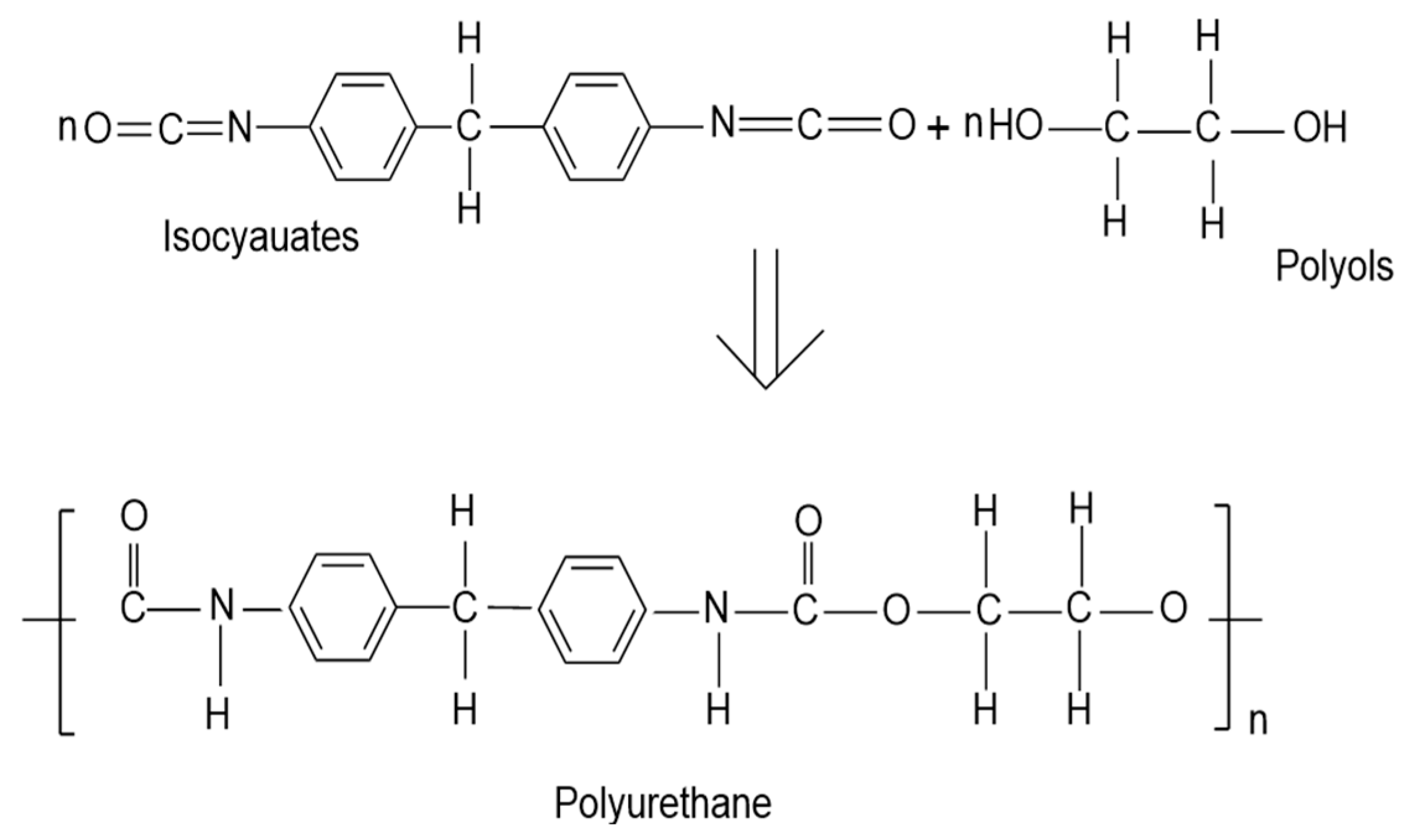
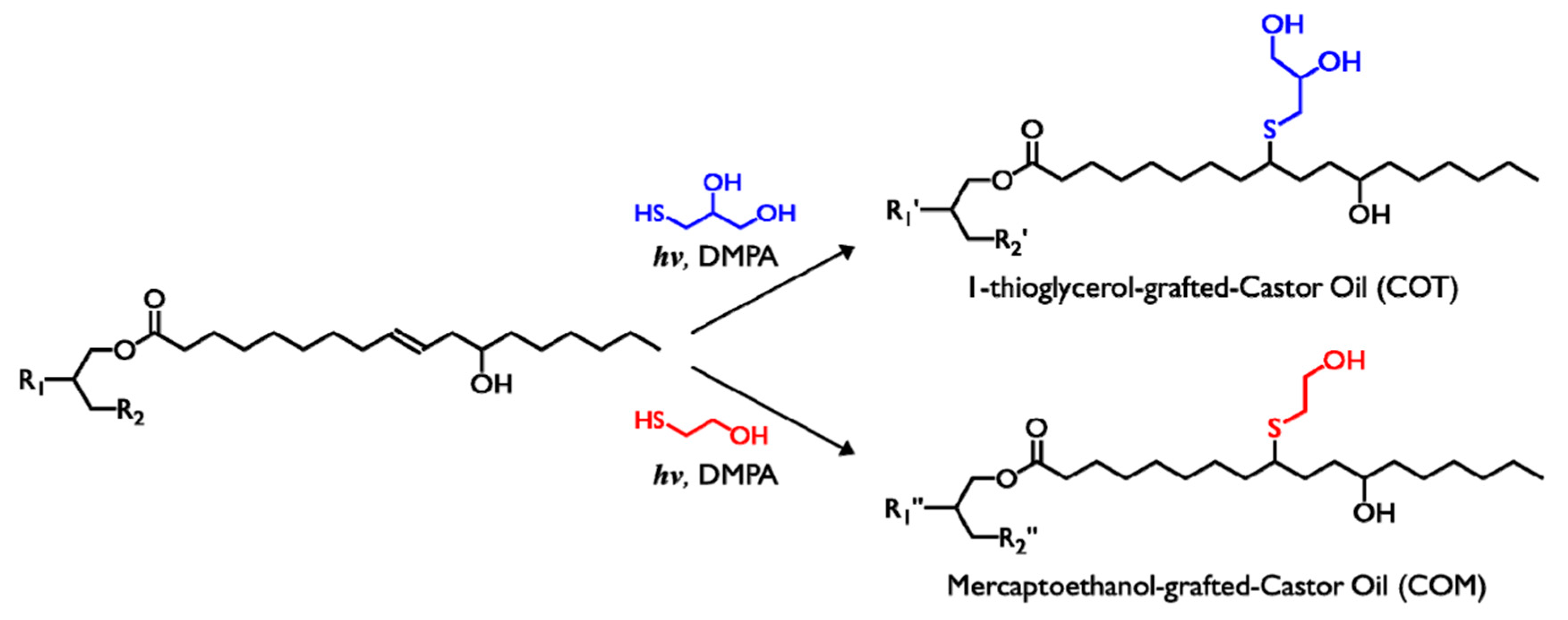


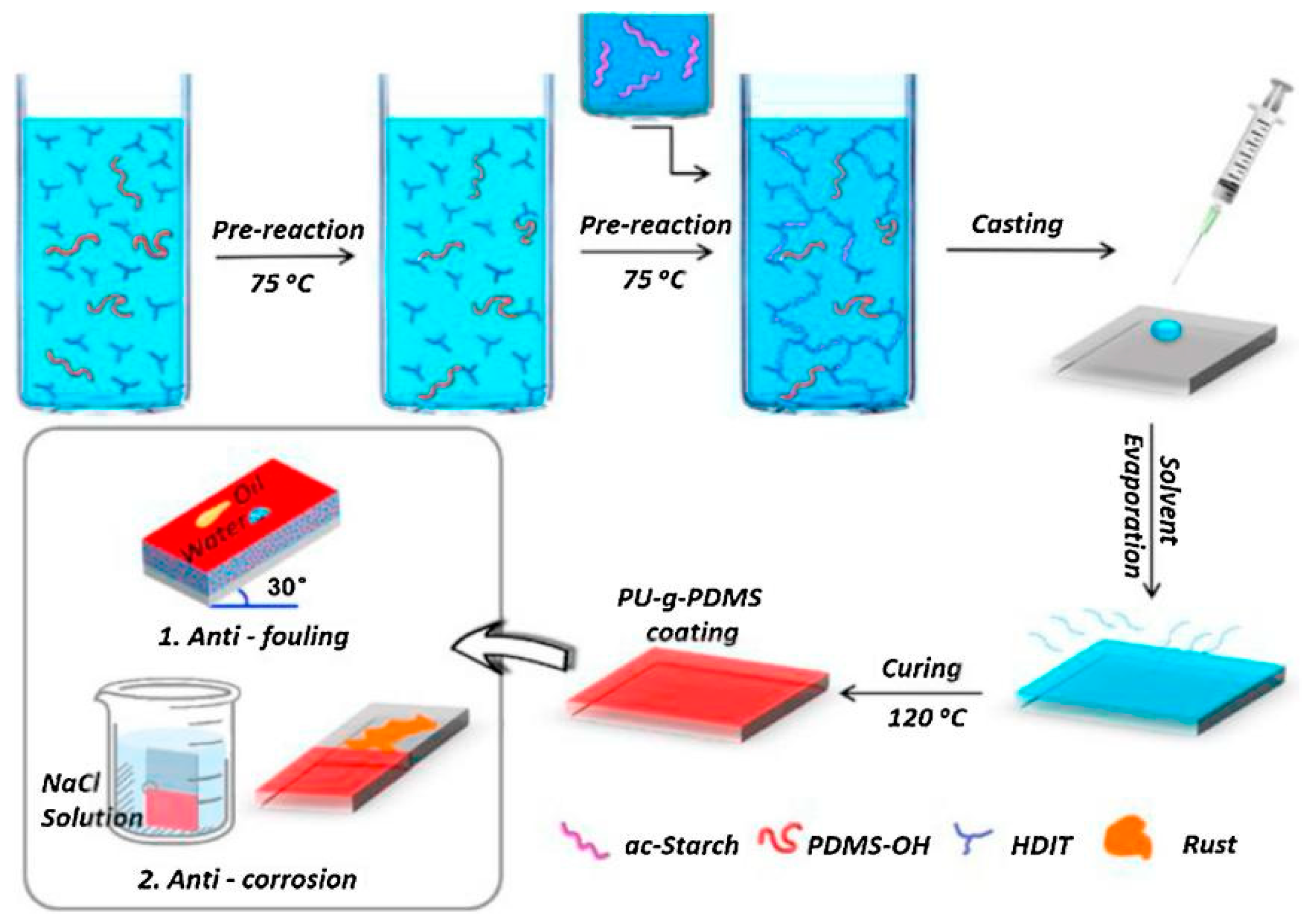

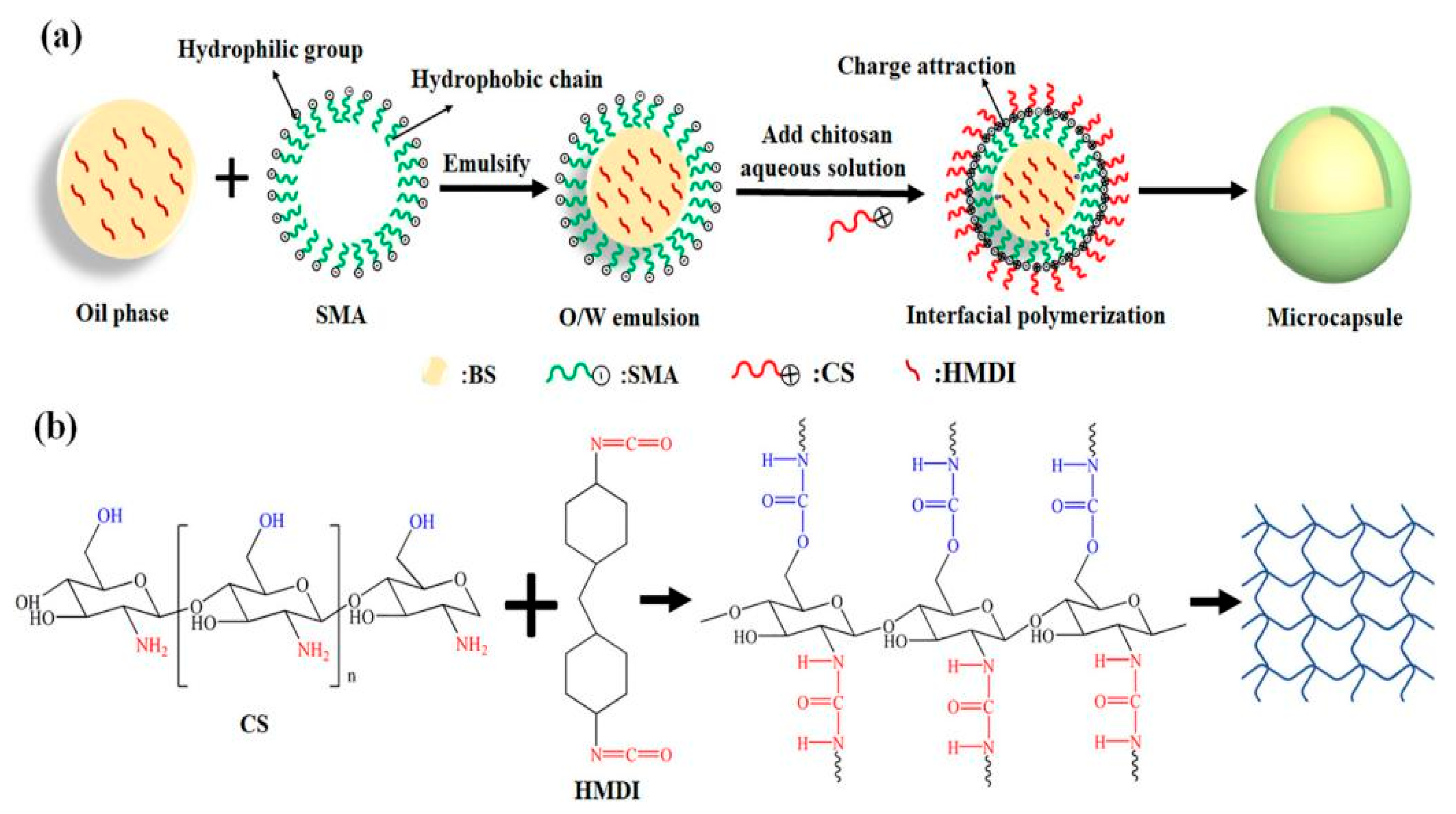

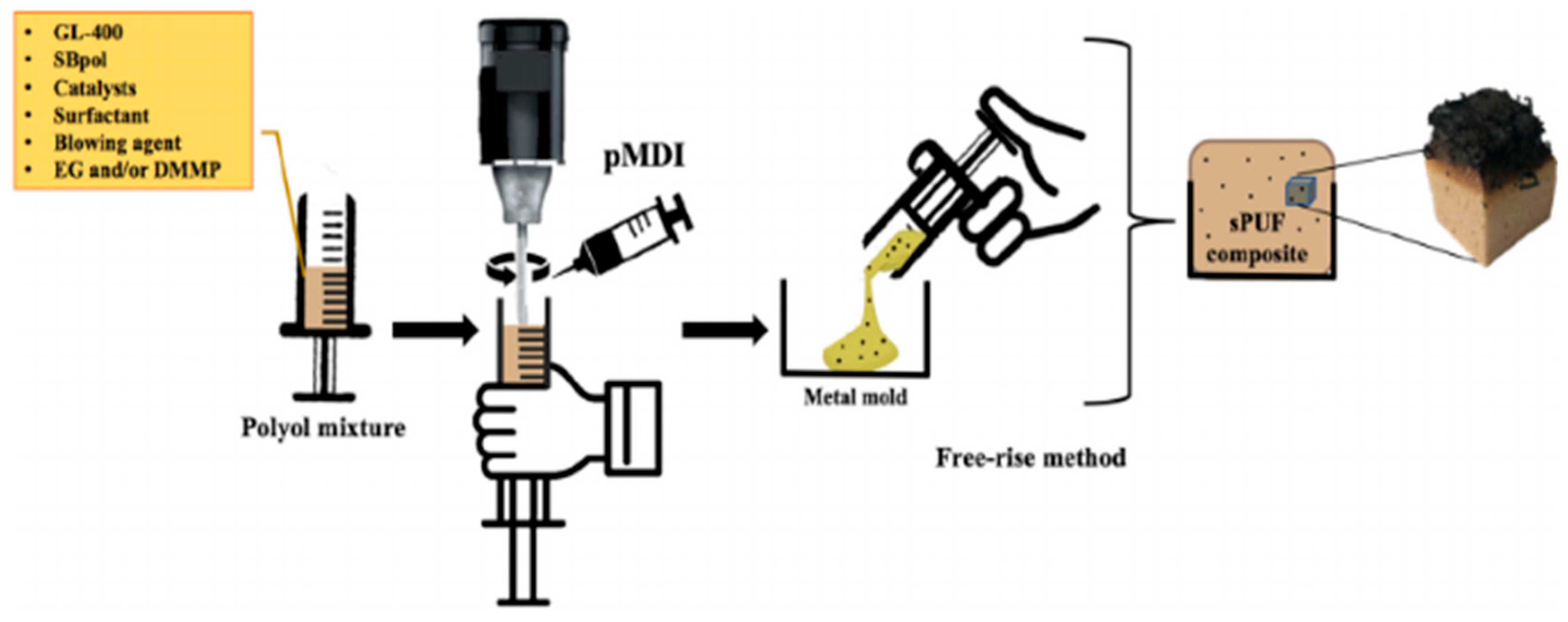

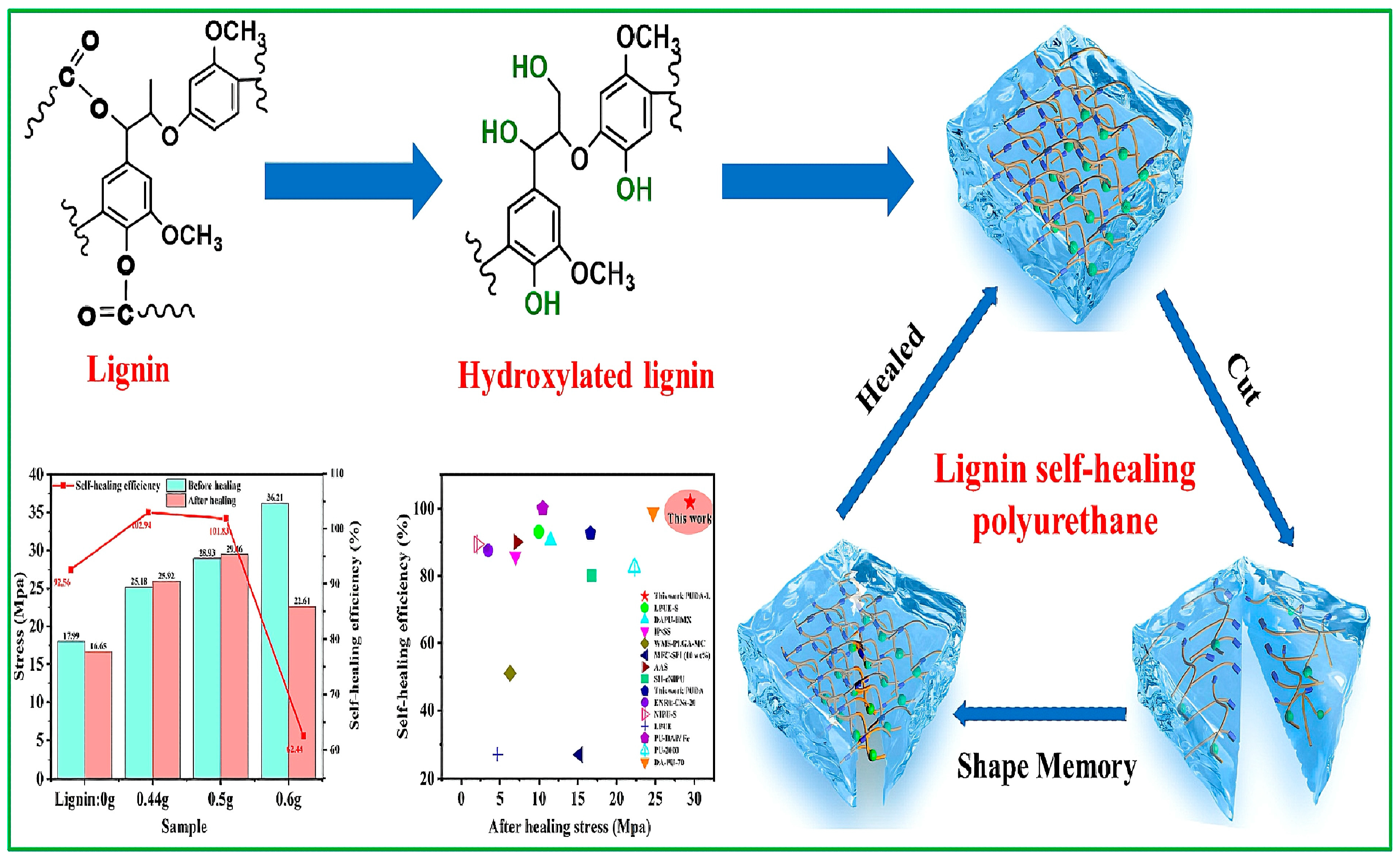
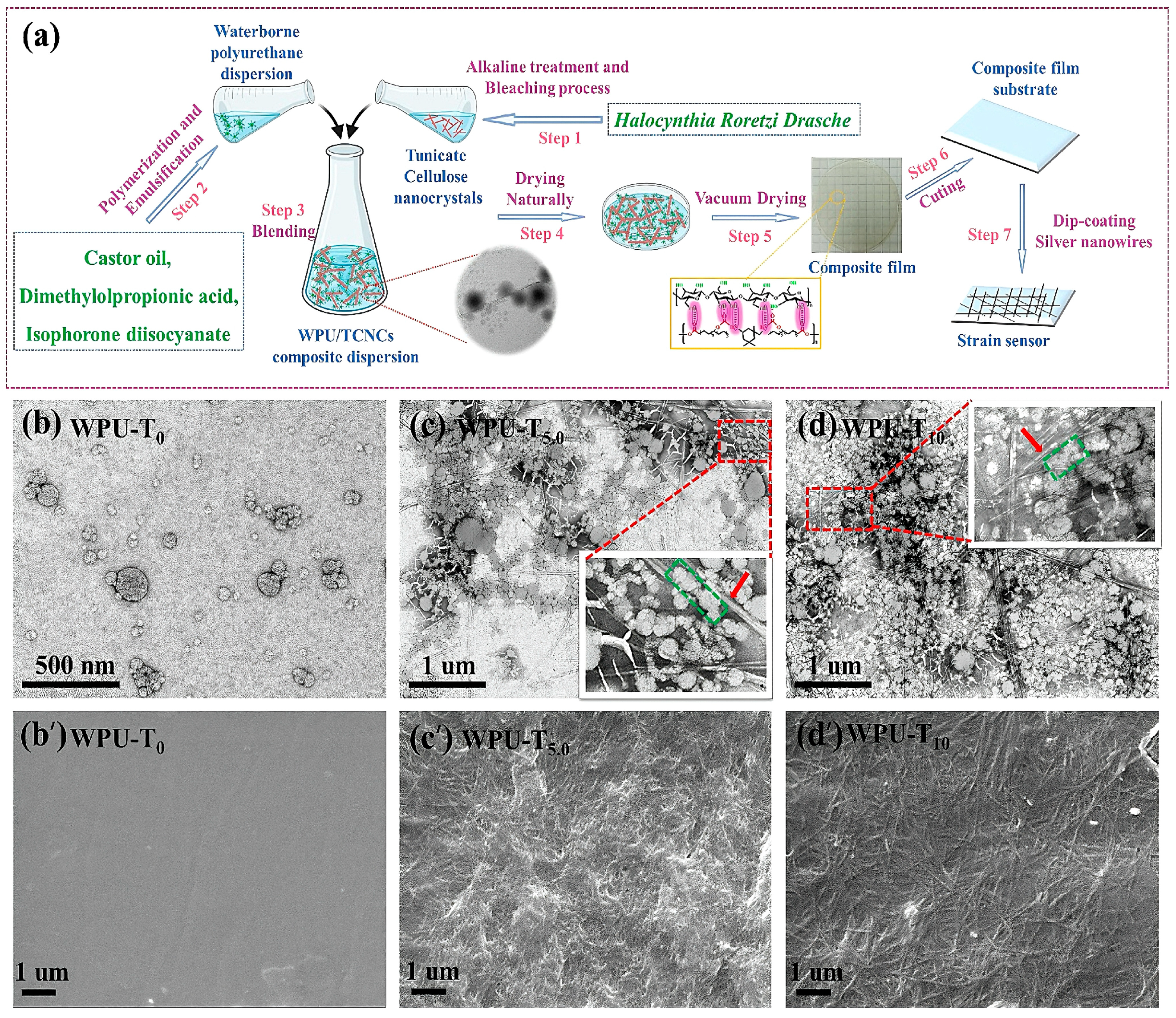
Disclaimer/Publisher’s Note: The statements, opinions and data contained in all publications are solely those of the individual author(s) and contributor(s) and not of MDPI and/or the editor(s). MDPI and/or the editor(s) disclaim responsibility for any injury to people or property resulting from any ideas, methods, instructions or products referred to in the content. |
© 2024 by the authors. Licensee MDPI, Basel, Switzerland. This article is an open access article distributed under the terms and conditions of the Creative Commons Attribution (CC BY) license (https://creativecommons.org/licenses/by/4.0/).
Share and Cite
Mo, Y.; Huang, X.; Hu, C. Recent Advances in the Preparation and Application of Bio-Based Polyurethanes. Polymers 2024, 16, 2155. https://doi.org/10.3390/polym16152155
Mo Y, Huang X, Hu C. Recent Advances in the Preparation and Application of Bio-Based Polyurethanes. Polymers. 2024; 16(15):2155. https://doi.org/10.3390/polym16152155
Chicago/Turabian StyleMo, Ya, Xiaoyue Huang, and Chuanqun Hu. 2024. "Recent Advances in the Preparation and Application of Bio-Based Polyurethanes" Polymers 16, no. 15: 2155. https://doi.org/10.3390/polym16152155





